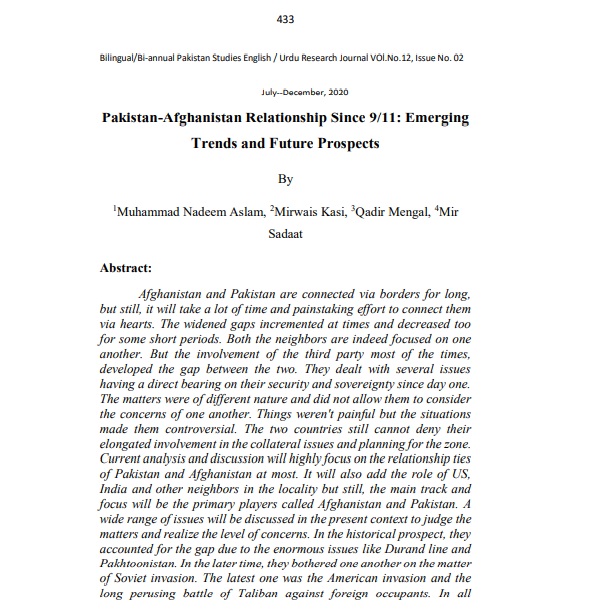Pakistan-Afghanistan Relationship Since 9/11: Emerging Trends and Future Prospects:
Keywords:
Emerging, Relationship, Pakistan, Afghanistan, Etc.Abstract
Abstract:
Afghanistan and Pakistan are connected via borders for long,
but still, it will take a lot of time and painstaking effort to connect them
via hearts. The widened gaps incremented at times and decreased too
for some short periods. Both the neighbors are indeed focused on one
another. But the involvement of the third party most of the times,
developed the gap between the two. They dealt with several issues
having a direct bearing on their security and sovereignty since day one.
The matters were of different nature and did not allow them to consider
the concerns of one another. Things weren't painful but the situations
made them controversial. The two countries still cannot deny their
elongated involvement in the collateral issues and planning for the zone.
Current analysis and discussion will highly focus on the relationship ties
of Pakistan and Afghanistan at most. It will also add the role of US,
India and other neighbors in the locality but still, the main track and
focus will be the primary players called Afghanistan and Pakistan. A
wide range of issues will be discussed in the present context to judge the
matters and realize the level of concerns. In the historical prospect, they
accounted for the gap due to the enormous issues like Durand line and
Pakhtoonistan. In the later time, they bothered one another on the matter
of Soviet invasion. The latest one was the American invasion and the
long perusing battle of Taliban against foreign occupants. In all regards, Pakistan justifies being a helpful neighbor in so many ways.
Both the countries need to realize the importance of their geographical
location to maintain positive relations. It is essential to be safe from
factors like terrorism in the locality. In general, and over all, this article
will throw light upon relations between Afghanistan and Pakistan from
each and every single angle to have a full insight of the relations
between the two nations and its impact on the global community.
References
References:
Afzal, M. (2020). Will the Afghan peace process be Pakistan's road to
redemption? Brookings. Retrieved from
https://www.brookings.edu/blog/order-fromchaos/2020/06/25/will-the- afghan-peace-process-bePakistan’s-road-to-redemption/
Afzal, S., Iqbal, H., & Inayay, M. (2012). “Terrorism and extremism as
a non-traditional security threat post 9/11: Implications for
Pakistan's security”. International Journal of Business and
Social Science. 3(24), 194 – 203.
Ahmad, I. (2010) 'The U.S. Afg-Pak Strategy: Challenges and
Opportunities for Pakistan', Asian Affairs: An American
Review. doi: 10.1080/00927678.2010.520572.
Akhtar, N. (2008). Pakistan, Afghanistan, and the Taliban. International
Journal on World Peace. 25(4). 49 – 73.
Aziz, K. (2016). “Why the distance between Pakistan and
Afghanistan?”. Conflict and Peace Studies, 8, 17 – 28.
Bukhari, S. N. S. (2005). Post 9/11 Pak-Afghan Border Dispute (A Case
Study of Durand Line). Editorial Advisory Board, 19(2),
-272.
Collins, J. J. (2011). Understanding War in Afghanistan. Washington,
DC: National Defense University Press.
Crawford, N. C. (2018). “Human cost of the post-9/11 wars: Lethality
and the need for transparency”. Costs of War. Rhode
Island, US: Watson Institute International & Public Affairs.447
Durani, M. U., & Khan, A. (2002). “Pakistan-Afghan Relations: Historic
Mirror”. The Dialogue, 4(1), 90-98.
Durani, Muhammad, K. A. (2002). Pakistan-Afghan relations: Historic
mirror. Pak: Qurtuba.Edu.
Hussain, S. and Siraj, S. A. (2019). “Coverage of Taliban conflict in the
Pak–Afghan press: A comparative analysis”. International
Communication Gazette. 81(4). 305 – 326. Retrieved
from
https://journals.sagepub.com/doi/abs/10.1177/17480485188176
Johnson, T. H., & Mason, M. C. (2007). “Understanding the Taliban and
Insurgency in Afghanistan”. Orbis. 51(1), 71 – 89. Retrieved
from
https://www.sciencedirect.com/science/article/abs/pii/S
Accessed on 24 Jul 2020.
Khattak A.S. (2014). Material and Methods. In: Mutual Sustainability
of Tube Well Farming and Aquifers. Advances in Asian
Human-Environmental Research. US: Springer, Cham.
Livingston, I. S., & O'Hanlon, M. E. (2017). Afghanistan Index. The
Brookings Institute.
Mamdani, M. (2002). “Good Muslim, Bad Muslim: A Political
Perspective on Culture and Terrorism”. American
Anthropologist. 104(3). 766 – 775.
Naqvi, H., Kazim, S. F., & Huma, S. (2011). Suicide bombing: a
geopolitical perspective. Journal of the Pakistan Medical
Association, 61(1), 74.448
Ollapally, D. M. (2008). In The Politics of Extremism in South Asia.
United Kingdom: Cambridge University Press.
Omrani, B. (2009). “THE DURAND LINE: HISTORY AND
PROBLEMS OF THE AFGHAN- PAKISTAN BORDER”.
Asian Affairs. 40(2). 177 – 195.
Rashid, A. (2010). “Taliban: Militant Islam, oil and fundamentalism in
Central Asia”. Foreign Affairs. 79(4), 159 – 160.
Retrieved from https://doi.org/10.2307/20049858
Saikal, A. (2012). Modern Afghanistan: a history of struggle and
survival (ed.). UK: I.B. Tauris.
Who are the Taliban? (2020, February 27). BBC News. Retrieved from
https://www.bbc.com/news/world-south-asia-11451718
Wynbrandt, J. (2009). A Brief History of Pakistan. US: Facts On File,
Inc.



